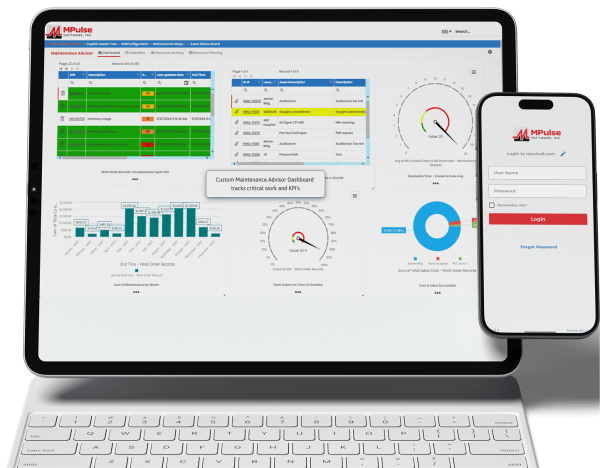Now more than ever, managing public works operations costs requires smart, proactive strategies to save money, prevent disasters, address citizens’ needs, and rebuild trust in government.
Additionally, government agencies continue to face considerable challenges. In particular, maintenance managers need to balance aging infrastructure, budget constraints, shifting regulatory compliance, changing technology, and community demands.
In the current landscape, public works operations must continue to prioritize effective management of community resources while controlling costs. CMMS software can help.
Table of Contents
Using CMMS for Public Works Operation Costs
Governments are responsible for public infrastructure, such as transportation, roads, parks and recreation, fire and police services, building evaluations, and utilities. However, effectively maintaining these community resources presents multiple challenges for public agencies.
CMMS can help by improving workflows, optimizing asset management, enhancing resource allocation, and facilitating data-driven decision-making. Many organizations are prioritizing cost reduction with CMMS in public works through the following methods.
#1: Streamlined Inventory Management
The fastest way to control the cost of maintenance in public works operations starts with managing parts and supplies. That’s because for most organizations, a large portion of capital sits in the stockroom. You can get your fastest return on investment (ROI) by implementing inventory management to save time and money by improving tracking, stocking, ordering, and inventory processes.
CMMS helps you manage parts and supplies by accurately tracking usage and reordering levels. As a result, you can prevent overstocking or stockouts, leading to efficient use of the budget allocated for parts procurement. Inventory management tools also can help your team quickly identify what they need for which piece of equipment. When an emergency arises, this information provides critical data for making cost-efficient decisions.
#2: Data-Driven Decision Making
Data-driven decision making at its core means making informed choices based on data. This approach makes maintenance more effective because it can serve as the foundation of every decision your organization makes about its assets. That data really comes into play when it’s time to make important decisions about the condition of your assets, like whether you should repair, replace it, or extend its life cycle.
CMMS software allows you to collect and report on data across your entire asset inventory, providing information to help you make better decisions and answer business-critical questions. You can use data analytics and modeling to help identify patterns and trends that might indicate safety concerns, allowing for timely interventions. You’ll also be able to purchase, operate, maintain, upgrade, or dispose of assets in the most cost-effective manner.
#3: Optimized Maintenance Planning
When your public works assets haven’t been maintained properly, you’re going to experience more breakdowns. That translates into lost dollars and intense pressure on the maintenance team to get things up and running again. By implementing preventive maintenance strategies, equipment and infrastructure issues can be addressed before they become major problems, reducing the need for costly emergency repairs.
Preventive maintenance for public works enables your team to schedule and manage maintenance tasks more efficiently. Public works software will generate a schedule of tasks, making it simpler to follow the manufacturer’s guidelines. As a result, organizations can sidestep serious problems that arise as a result of neglect, as well as delay more expensive maintenance.
#4: Reduced Downtime
A proactive maintenance strategy minimizes downtime, ensuring that public services are not disrupted and saving on potential revenue losses. Properly maintained assets perform more efficiently, use less energy, and fail less often—extending their usable life. Regular monitoring and maintenance can reduce the need for premature replacements and save significant funds in the long run. Well-maintained assets also are more likely to withstand adverse conditions and recover faster.
CMMS allows your team to schedule and track maintenance tasks, leading to faster responses when equipment needs attention. Regular inspections help catch problems early and ensure equipment is calibrated and lubricated on time. Maintenance can be scheduled based on time, usage, or condition, triggering work orders before system inefficiencies or failures happen.
#5: Better Workforce Efficiency
Maintenance professionals benefit from quick and easy access to key resources, particularly historical data, vendor contact information, documents, videos, photos, websites, intranets, and more. CMMS streamlines work order management, assigning tasks to the right personnel and providing them with detailed instructions. Best of all, all the information is stored with the work order or asset record, so it’s easily accessible the next time around.
For public works operations that engage with contractors or service providers, CMMS also can help manage contracts, warranties, and service agreements. As a result, your team can ensure that services are delivered as promised and that contracts are maximized for value. That helps you improve the productivity of your maintenance team, reduce time spent on diagnostics, and allocate resources effectively.
#6: Asset Performance Monitoring
Infrastructure asset management allows agencies to track the condition of their equipment and assets in real-time. This strategy is often more cost-effective than reactive maintenance, as it prevents major failures that could result in higher repair or replacement costs. Effective asset monitoring and maintenance also demonstrate agencies’ commitment to providing safe and reliable services to the public, enhancing trust and confidence in government services.
CMMS provides real-time data on asset performance, enabling early identification of potential issues. Well-maintained assets are less likely to fail, ensuring public services like water supply, sewage management, and transportation stay operational. Monitoring assets also helps agencies find ways to reduce energy or resource use, supporting sustainability and lowering environmental impact.
#7: Resource Allocation
Public works operations need to track resource utilization, including labor, materials, and equipment. Resource allocation tools enable agencies to prioritize projects based on factors like public safety, critical infrastructure needs, and community impact. As a result, agencies can efficiently allocate their limited resources, such as budget, manpower, equipment, and time, to various projects and tasks.
CMMS software can help agencies track expenses, allocate funds to different projects, and avoid overspending, ensuring financial sustainability. These tools enhance transparency by providing a clear overview of how resources are distributed among projects. This approach fosters accountability, as agencies can demonstrate to stakeholders how resources are being used to achieve objectives.
#8: Regulatory Compliance
When it comes to regulatory agencies, however, it’s either documented or it didn’t happen. CMMS ensures maintenance tasks are completed and documented properly, reducing the risk of fines or legal issues. It also helps public works agencies create and practice emergency response plans, improving their ability to handle natural disasters, accidents, or other unexpected events.
#9: Long-Term Planning
Public works agencies need to ensure the long-term sustainability of critical public assets. That requires continually assessing the condition of existing infrastructure and planning for necessary repairs, renovations, and replacements. With long-term planning tools, agencies can accurately estimate future funding needs for infrastructure projects and allocate budgets accordingly. As a result, they can prevent sudden budget shortfalls and enable agencies to secure funding in advance.
Public works maintenance software can help prioritize tasks based on factors such as urgency, impact, and available resources. You can also help predict future resource needs using past data and trends, allowing agencies to plan ahead, anticipate shortages, and make necessary adjustments. This data provides the basis of communicating plans and priorities to various stakeholders, including government officials, citizens, and contractors. Transparency builds trust and ensures everyone is on the same page.
For public works, CMMS benefits include efficient maintenance practices, reduced downtime, optimal resource allocation, and improved decision-making for government operations.
To achieve the maximum cost-saving benefits, it’s important to tailor your CMMS to the specific needs the public works environment. Contact MPulse to learn how to get started or get a free trial.






